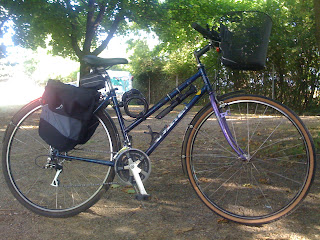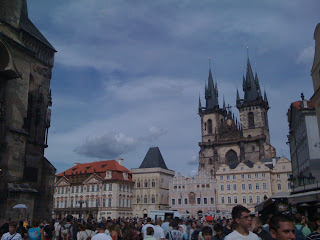Our brief trip to Poland took us to Oswiecim, Poland where the concentration/extermination camps Auschwitz 1 and 2 (Birkenau) are preserved and now museums. They are also UNESCO world heritage sites.
I really wanted to visit and it has been on our list of places to go but as time got closer I was apprehensive of what it would be like...tourists in a place like that etc. We met a man in Vienna (he was from Worcester!) who had been in the last week or two and he reassured us. He felt that it was in the end uplifting that Auschwitz was there for us to learn from and that what happened would not be forgotten. We also talked about the experience of visiting for people from different parts of the world, us from Britain, German, Jewish, Polish visitors. I say visitors now because after going it wasn't about tourism.
We stayed at The Centre for Dialogue and Prayer which is about 200m away from the site, it seems to be a Christian based centre with a hotel and camp site attached. Really convenient for us, most people make a day trip from Krakow on the buses although there are two car park type campervan stops at the site and opposite it. I'm glad we didn't stop there though it was nice to have a green garden to be in before and after, and the loos were nicer!
The tour of Auschwitz is done with a guide and about 15/20 people to a group and you get a headset so you can hear the guide. This also has the desired effect of people not talking to each other while you go around. Although I think most people would be silent throughout anyway, except for the children that people brought with them. It may be just me but I think I might censor some of the realities of history from my young children.
So we walked around and we saw where people walked in when they arrived, under the arch saying 'Work brings freedom' and along past all the blocks where the prisoners slept. This was already a Polish barracks before the Germans arrived and we, not knowing this, were surprised at how solid it all looked as images of low temporary looking buildings were in our heads. About four or five of the blocks have been made into museum type exhibits from pictures to personal belongings and documents displayed. The walls of photos of the prisoners look down on you, these were taken after people had been stripped of belongings, hair and given their prisoner uniform and number. They all have their name, date of arrival and death, most didn't survive past 3 months. The most affective parts for me included walking up and down the stairs which were worn down from all the previous feet that had been there and the personal belongings. Some of the room had been sectioned off so a third of a 20m room would be behind glass and then filled with items. We saw hundreds, thousands of children's shoes piled up, suitcases all with people's names on and a room just filled with women's hair. The hair was something else.
The guide was quite factual and kept to the point there wasn't much expansion or discussion from what was already written on boards around the place. After the barracks you go to the death wall where people were shot, the gallows where people were hung in front of the other prisoners and then the prison within a prison. isolation cells and the first small room where they experimented with gas poisoning and came up with the idea for Birkenau, the extermination camp. The room where people were gassed and the adjoining room with the ovens still intact. The old electric fences are mostly still in place as are the watch towers.
After two hours of this tour you then go by shuttle bus about 2km to Birkenau, this is the one I felt I'd seen on the TV. The arch way with the train track coming up to it, the long platforms the length of the camp and one storey brick buildings. This place is huge, it is sprawling. Many of the buildings were destroyed but the chimneys of each block have been rebuilt and there are remnants of walls left. Some buildings have been rebuilt and one of the women's blocks still has the stove and wooden slatted 'beds'. There is a train carriage on the platform so you can see the space 80 people were made to stay in for their deportation journey. Up to 5000 people arrived here in a day and many were immediately killed and not registered as being there at all. Those who looked fit enough to work were kept alive (just) and registered at the camp.
At the far end of the site there is a huge memorial with stones with an inscription in many different languages saying the same thing (see the picture below), this is inbetween where the two gas chambers were. They were destroyed by the Germans at the end of the war but you can still get the idea with one of them. On the other side of one of these buildings the ground is like a pit and all white, this is where all the ashes were dumped. The forest at the back of the site was used for open air burning of corpses when they could not keep up with the amount in the ovens in the buildings.
You can visit Birkenau for free and without a guide and its size and preservation makes it a different experience to the enclosed rooms that you visit in Auschwitz.
I read Victor Frankl's Mans Search for Meaning before we went, his book is made up of two essays one on his experiences as a prisoner and his reflections on the psychological processes he and others went through to survive or not in Auschwitz and other camps. His second essay is his theory on the psychological treatment of people who have been prisoners. He wrote shortly after his release in 1945. Even if your not interested in the theory (its a bit hard going!) the first essay is a succinct and insightful account of camp 'life'.
In conclusion, its an experience but one that is worth it on different levels. A history lesson in reality and a lesson in human behaviour, something that should never be forgotten.
Here's some pictures...



















































